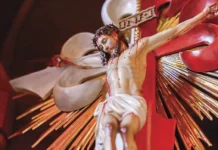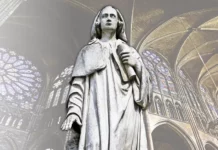By 2am on that dark night, all illusions had vanished. Minutes later, the waters of the Atlantic Ocean engulfed once and for all the proud titan of the seas. With it sank the foolish optimism of an entire generation.
It was the end of the Belle Époque,1 a time marked by the search for the enjoyment of life, of a carefree and leisurely joy, and by great scientific and industrial advances that gave humanity a sense of security, stability and self-sufficiency. However, everything was heading rapidly towards a tragic end: the First World War.
It was within this historical context that the White Star Line shipping company, at the initiative of its president, Joseph Bruce Ismay, completed the construction of the Titanic, whose inaugural voyage, bound for New York, began from the port of Southampton on April 10, 1912.
On that day, the risen sun was especially bright, the sky was clear and a mild breeze was blowing through the city, while the birds seemed to be flying with more vivacity than usual. Everything seemed to augur the success of the largest ocean liner ever built.
It is said that while a distinguished lady of English society, Mrs. Cadwell, watched the porters loading her luggage, she asked one of them:
“Is this ship really unsinkable?”
“Yes, madam! he replied. “Not even God can sink it!…”
A bold statement… However, those words did not merely represent the opinion of a simple sailor, but reflected the secularist mentality, obsessed with progress, that pervaded English society at the time. The gigantic ship deluded the minds of both those who built it and those who boarded it.
Great and varied social gathering
The Titanic left Southampton carrying more than two thousand passengers, including nobles and millionaires, components of the high society of the time, along with Bruce Ismay himself. Several of them were regulars on the voyages commanded by the renowned Captain Edward Smith, who, at sixty-two years of age, would navigate for the last time at the helm.
Besides the magnates and wealthy folk who constituted the first and second class, there was a third class aboard, composed of emigrants on their way to the United States full of hope, in the expectation of acquiring a considerable fortune in the New World that would allow them to break free from their labourer status.
More than just a common crossing of the Atlantic, this trip can be considered a great and varied social gathering. On the decks of the modern ocean liner, people of all levels were optimistic about the delightful “sea of dreams” that the illusory world offered them.
Heading heedlessly towards disaster
On Sunday, April 14, the day also dawned serene and sunny. However, at 9am the radio operator received a dispatch from the Caronia, a vessel that was also sailing through that area, warning of the presence of ice on the sea surface. No one, however, gave the matter much importance.
At 1:40pm, a new message was received from the Baltic, also from the White Star Line, warning about numerous icebergs sighted precisely on the route the Titanic was following. The telegrapher dispatched the message to the command room, and the officer in charge sent it to the captain.
As it was lunchtime, Captain Smith chose to finish his meal calmly, after which he headed to the deck in search of the company president, who was taking a stroll. However, the latter, after receiving the message, placed the paper in his pocket and continued his walk.
No one along the entire command chain wanted to trouble himself about the danger. They all preferred to pass it on to a superior or put aside that “annoyance” that threatened to spoil such a pleasant crossing.
It was not long before the SS Amerika and the SS Californian sent new messages to the Titanic, but the radio operator, Jack Philips, as optimistic as all the others, paid them no heed.
The lack of vigilance and shameful disregard that so often precedes great disasters in history was rife among that crew… Their remiss and absurd attitude heralded the inevitable tragedy; the collision would not be long in coming.
Later investigations raised the suspicion that the decision not to slow down the vessel or change its course was due to pressure on the captain by the company president, Joseph Bruce Ismay2… Captain Smith’s years of experience made him aware of the danger the icebergs posed in those waters. However, it seemed more important to him to help maintain the prestige of the company by avoiding manoeuvers that would result in the crossing taking longer than expected…
Besides, it was just not plausible to think that such a large, powerful and well-built ship could sink at the very height of an age of success and development.
That night, the captain retired, without giving much importance to the gravity of the situation. As the stars glittered in the dark vault of a moonless sky, the lights in the salons and cabins were gradually being extinguished. In the ship, calm reigned; in the sea, the icebergs loomed menacingly…
Cunning work of the devil
This blindness and consequent inaction in face of such imminent danger are distressing, and they prompt us to ask ourselves what was the reason for this collective “inanity”.
Now, analysing the facts in greater depth, we can perceive in this historical episode the discreet, almost imperceptible presence of the devil, master of using a sagacious and very efficient tactic in his operations.
To better understand it, let us think about how cancer acts on a person. It is a potentially deadly disease, whose main danger lies in the fact that it is, at first, imperceptible. The affected cells silently form tumours in the organism, and when the individual begins to feel its symptoms, the damage has often already become irreversible.
Thus also satan acts. His trick is to influence souls by working discreetly. By the time his presence is perceived, a thousand defects and miseries have already taken root in the soul, making it very difficult to fight them.
Now, this is not the worst artifice of the infernal enemy. There is an even more harmful way of attacking the children of God: to clothe himself with good appearances! Such are the “ravenous wolves” who disguise themselves as “good sheep”, against whom the Divine Redeemer warns us in the Gospel (cf. Mt 7:15).
On these occasions, evil appears under the veil of supposed virtue in order to be able to undermine its prey without hindrance. Dazzled by the beauty, tenderness and whiteness of the false sheep, victims are unable to discern anything bad or dangerous and allow themselves to be devoured. The warnings given to them are usually of no avail.
Thus, it could be said that the state of mind of the crew and passengers of the Titanic had its origin in a terrible “cancer” called worldliness. Or, perhaps, that they were attacked by a fierce wolf disguised as an innocent sheep, known as human progress.
They saw this treacherous world as a sea of harmless, wonderful and endless pleasures, when, in fact, it is only the transitory battlefield on which our eternal destiny is decided. They relied on advances in science and technology to the point that they considered themselves immune to any disaster, as if our lives were not governed from above by Almighty God. When their illusion dawned on them, it was already too late
And the inevitable happened…
Around 11:30pm on that seemingly serene moonless night, watchmen Frederick Fleet and Reginald Lee beheld from the watchtower a sinister image: a gigantic dark block floated only five hundred metres off the bow of the boat! The monstrous obstacle had not been spotted before, because those responsible did not have binoculars…3
Soon three alarm bells rang, and the command post received a warning by phone: “Iceberg just ahead!” The first officer, William McMaster Murdoch, had no time to take any preventive action; all he could do was shout, “Turn off the engines and full left rudder!”
The order was obeyed in all haste, but the obstacle was too close. What seemed impossible became inevitable: the Titanic collided violently with the ice and gradually lost speed until it stopped… It was mortally wounded!
The shipbuilder, Thomas Andrews, accompanied by Captain Smith, hastened to make a survey and immediately acknowledged that all was lost. The Titanic could continue afloat with three of its sixteen watertight compartments damaged. Stretching the limit, it could possibly withstand having four of them completely flooded. However, the iceberg crashed into the ship so hard and at such an angle that five compartments were hit at once.
The gravity of the situation prompted them to wake up the crew who were not on duty at the time: “Turn out, you fellows; you haven’t half an hour to live. That is from Mr. Andrews. Keep it to yourselves, and let no one know.”4
There were, in fact, no bells, no sirens, no general alarms. The news was spread from person to person, asking all passengers to gather on the deck wearing their life jackets.

at right, the last lifeboat to be lowered from the Titanic, photographed by a passenger on the ship Carpathia
How did the passengers react?
Inside the ship, the fatal blow was only felt as a slight jolt. It is said that in the smoking room, poker players were still awake at this hour. They felt a slight tremor and saw a mountain of ice over twenty metres high glide by the windows. However, the night seemed beautiful and calm to them. They never bothered to leave the room or ask for information. After all, they were on the Titanic, the great transatlantic liner that “not even God could sink”…
Little by little, reality became undeniable. While most people slept, the sea flooded the ship. In a few minutes, two and a half metres of water covered the boiler room. Not even that could dispel the absurd optimism of most passengers, and many still wondered if they were really sinking… As the staff woke them up and helped them to don their life jackets, some smiled, thinking the measure excessive.
At half past midnight, the order was given: “Women and children to the lifeboats.” Fifteen minutes later, the first of them was lowered to the sea. All in all, the evacuation was carried out slowly and in a disorganized manner.
Several of the sailors did not even know how to launch the lifeboats properly because they had never been trained to react in case of emergency… Due to the lack of expertise of those responsible, only four of the twenty boats available were loaded to more than seventy percent of their capacity.
Besides the incompetence of the crew, another factor contributed to the failure of the operation: many passengers refused to enter the boats! They felt much safer on the Titanic and did not believe in the imminent sinking. Many women, who would have been the first to evacuate the ship, refused to do so because they considered it impossible that the ship would sink.
At first, there was no sign of panic among the passengers. One of the reasons for this is the fact that the ship’s own crew made them believe that it was all just a training exercise… Moreover, the orchestra kept playing cheerful melodies in order to keep everyone calm.
To what extent would that general obstinacy persist, which had already surpassed all imaginable limits?
Finally, reality takes hold…!
While many hesitated or even refused to believe, the Titanic’s career was coming to its close. It would soon be buried in the waters.
At two o’clock in the morning, the final moment approached, of the slow and dramatic descent of the titan of the seas to the depths of the Atlantic. Only then, when faced with the seriousness of death, were the ridiculous illusions of the most recalcitrant broken and their worldly trust dashed. Some remembered God and began to pray. Others ran wildly through the corridors and halls of the ship, given over to despair.
At 2:17am, all the lights on the ship were out. Amidst the darkness, it was possible to see people throwing themselves from every side into the icy sea as a final attempt to save themselves.
At 2:20am on the fifteenth of April, the ocean waters closed forever upon the proud ship and with it sank the foolish optimism of an entire generation. The sinking of the Titanic brought to light, in some way, the deception of this atheistic and hedonistic way of life.

Today’s world: a “new Titanic”
Only six hundred and sixty of the more than two thousand people who boarded in Southampton survived the shipwreck. But, alas! How many opportunities were there to avoid or mitigate such a great catastrophe!
If the captains had given real importance to the warning messages about the icebergs received on Sunday… If binoculars had been available among the equipment of the lookout, they would have been able to spot that huge block of ice one minute earlier… If the crew had been trained to act correctly in that emergency… If the passengers had believed in the imminent danger… How many of those 1,500 lost lives could have been saved!
Now, who knows if, as happened millennia ago in the Tower of Babel, God did not allow man, in the sinking of the Titanic, to be the victim of his own pride? Did He not consent to this failure as a deserved punishment for man’s arrogance at the beginning of the century, daring to defy the Creator with his scientific knowledge?
Analogies are not lacking also between our days and the sinking of the mighty ship. Faced with the moral, social and intellectual decadence in which we live immersed, faced with increasingly more frequent natural disasters, whether provoked by humans or not, faced with pandemics and mysterious diseases that threaten the entire world, modern man insists on being turned in on himself.
And “this undying optimism, which does not change in the face of the most evident manifestations that things are going badly, indicates insensitivity to the plans of Providence, and ultimately a divorce between men and God.”5
Humanity has already received countless warnings about the danger that threatens it. Chief among them was the one given by Mary Most Holy herself at Fatima, a few years after the historical episode we have just recalled. Was She heeded by those who call themselves her children? Or did people judge, as has so often happened throughout history, that the “powerful ship” of the world is “unsinkable” as the Titanic was supposed to be?
What is certain is that, since the expulsion of our first parents from Paradise, God declared that Our Lady’s lineage would overcome that of the serpent. And so Our Lady promised: “In the end, my Immaculate Heart will triumph!”
Therefore, let neither the solidity of our ship concern us, nor the violence of the waves that shake it in the midst of victory, nor yet the treacherous icebergs. Whatever difficulties we encounter along the way, Mary Most Holy’s promise guarantees the success of the voyage. ◊
Notes
1 Period between 1890 and 1914, just before the First World War, characterized by economic and cultural prosperity.
2 Cf. VALLS SOLER, Xavier. Titanic: el naufragio del orgullo. In: www.lavanguardia.com.
3 Idem, ibidem.
4 UNITED STATES SENATE INQUIRY. Testimony of Samuel Hemming, April 25, 1912. In: www.titanicinquiry.org
5 CORRÊA DE OLIVEIRA, Plinio. Conference. São Paulo, July 25, 1969.











